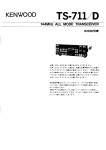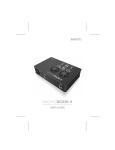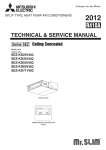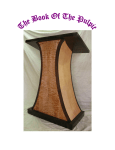Download Suwa Seikosha`s Television Watch
Transcript
© 2001 National Association of Watch and Clock Collectors, Inc. Reproduction prohibited without written permission. Figure 1. The Seiko television wristwatch. If you’re old enough to recognize the RCA “Indian head” test pattern, then you probably need glasses to see the screen. Suwa Seikosha’s Television Watch by James A. Mahaffey (GA) Shortly after the watch was invented, there was a movement to add personal entertainment activities to the watch’s practical functions. These embellishments were designed strictly to amuse the owner while retaining a timekeeping function. At first automata were added, or little animated figures making small, repetitive motions, such as swinging a hammer or waving a handkerchief. Next, subminiature music boxes were added to play upon demand or upon the hour, sometimes combined with an automata scene. There was a limit to how much entertainment would fit in a pocket watch, and the introduction of the wristwatch further limited the amount of space available for non-timing machinery. Then, in the 1970s, fully electronic watch mechanisms became practical manufactured items, and the possibilities for personal entertainment seemed endless. AM radios, FM radios, music synthesizers, and arcade games have all been incorporated into electronic watches, as well as many practical auxiliary functions ranging from digital calculators to global positioning system receivers. The ingenuity displayed in the miniaturization of devices to be included in personal timepieces is impressive, but nothing in amusement systems may quite surpass the bold design of Suwa Seikosha, who put the world’s smallest directview television screen in a wristwatch. Suwa Seikosha was one of several manufacturing companies in the Seiko Group, which evolved from K. Hattori & Company, an import/export trading company specializing in clocks and watches, established in 1881. In 1964, Suwa Seikosha established a solid reputation in the clock business by building the automatic timers for the Tokyo Olympic Games. In 1969, the company perfected the world’s first quartz watch, and in 1973 introduced the liquid crystal display (LCD) as a time read-out on a wristwatch. February 2001 On June 16, 1982, Suwa Seikosha, in the Hotel Okura in Tokyo, announced to the world the result of years of development and several hundred million yen —the television watch. Into a rectangular metal case, 76 by 143 by 18 millimeters and weighing 190 grams, they had integrated a conventional LCD quartz watch and a 1.2-inch (diagonal) television monitor. The receiver fit in a pocket-sized box (74.5 by 125 by 19 millimeters, 140 grams), and conducted video signals to the monitor though a flexible 6-conductor cable. The user was to wear headphones which connected to the receiver box and served as an antenna. The electronics press was enchanted by the tiny TV picture, but was a bit skeptical that this watch would sell enough units to justify the estimated two trillion yen (about 10 million dollars) necessary to tool up for production. The United States was the targeted market, so the receiver was built to decode National Television Standards Committee (NTSC) signals, and the retail price was set at $495. There were still problems to be solved. The display looked dim, with only 20 to 30 percent contrast using 10 levels of gray, and the refresh rate was too low, causing rapidly moving pictures to smear. The linear refresh-rate was 50 to 100 millimeters per second, and it would have to be increased significantly before production. Shelf-life of the television screen module was estimated to be seven years. The design was protected by 10 basic patents and 150 related patents, and there were still these kinks to be worked out. Although the LCD was a mature technology by this time, the process of ultra-miniaturized, animated display was on the frontier. The usual nematic LCD technology was too slow for this application, by orders of magnitude. For this specific product Suwa Seikosha developed a field effect (FE) very large scale integrated (VLSI) circuit having 31,920 pixels, arranged in a 150 NAWCC BULLETIN 41 © 2001 National Association of Watch and Clock Collectors, Inc. Reproduction prohibited without written permission. by 210 element matrix, on a single silicon wafer 30 by problems encountered in mass-producing the TV-moni22 by 1.4 millimeters. On this chip was sufficient cirtor chip. Although the U.S. market did not live up to cuitry to decode an analog NTSC signal and address Seiko’s expectations, the TV watch did infiltrate poputhe digital LCD array, given a separate frame-timing lar culture via Hollywood, appearing in the movies signal. Refresh rate problems were resolved, and proDragnet, Wall Street and Octopussy. duction began at a special factory in Fujimi, Japan, Although there were plans to use this technology as with watch assembly in the Shimauchi Precision a springboard to making a wristwatch computer disInstruments factory in Matsumoto. play terminal, introduction of such a device would wait Timing of the announcement was critical, as Sir for another decade. Suwa Seikosha and the Epson CorClive Sinclair of Sinclair poration merged in 1985, Research Ltd. was leakforming the Seiko Epson ing information about his Corporation. Sinclair’s TV impending wristwatch TV watch never appeared. to be offered in the near How the TV Watch future. Production watchPerforms es went on sale in early 1983, initially with one The initial production watch given to each Seiko model is rare, and most dealer. The earliest modexamples to be found are els, designated T001the model T001-5019. A 5000, were sold in a silver specimen is shown in Figcolored cardboard box, ure 1, and Figure 2 shows with a silver colored the watch in relation to its leather case to protect the receiver module. This receiver module. A model closely resembles mechanically delicate the prototype, except that pair of stereo headphones the name “Suwa Seikwas included, and the 6osha” on the prototype conductor connecting cord was changed to “Seiko,” was packed separately. and the legend “TELEVITwo AA-cells were providFigure 2. The TV watch with its receiver unit, connected SION WATCH” across the ed as an initial power by a cable. The cable runs under your sleeve, with the top was deleted from the source. The only optional receiver in an inside jacket pocket—a handy feature for production model. The accessory was an AC church services, weddings, and other enforced events. cable connector atop the power adapter, part no. case is bolstered on each TD02. The earliest example of a T001-5000 I have side by metal brackets, cast en-bloc with the case. This found is serial no. 200646. watch was sold in a gold colored cardboard box, with a The initial production watch differed externally sewn black leather case to hold the receiver. from the prototype watch in a few cosmetic details. The The watch portion of this system is a conventional screen and watch display in the production model had quartz watch with an LCD array, with time (12 and 24a black frame surrounding a satin chrome frame, with hour), alarm, date, and stopwatch functions, controlled watch button functions denoted in the black area, by three push-buttons. where the prototype was strictly cased in satin chrome. The “liquid video display” (LVD) operates passively, The cable connector, which had to be a robust design to in that there is no illumination behind the screen, and survive long in the hands of the consumer, was hidden viewing light is incident. There are two advantages to behind a satin chrome shroud in the prototype, but this this design: it saves a great deal of power, and the was reduced to a black plastic block in the initial proscreen can be seen in bright sunlight that would comduction model. pletely wash out a conventional TV picture. The disadSales were disappointing, and production lasted vantage is that the image is rather dim. The engineeronly about a year. The total number of watches proing problem that leads to this lack of brightness is that duced is hard to determine, with estimates ranging 150 conductors must run over the top of the display to from 2,000 to 20,000; non-consecutive serial numbers supply the vertical address to pixels, and these printed were used and provide no help in determining produc“wires” block the light. This is not noticeable in most tion quantities. The company had hoped to build 13,000 LCD panels because so few picture elements are used, but may have been unable to meet this quota. A limitbut in this case the panel is crowded with unusually ing factor from a manufacturing standpoint was the dense pixels. 42 NAWCC BULLETIN February 2001 © 2001 National Association of Watch and Clock Collectors, Inc. Reproduction prohibited without written permission. Figure 3. A page from the TV watch user’s manual. Once you get used to the dimness of the television image, the sharpness and the apparent richness of detail are startling. You can easily read numbers and written words flashed briefly across the screen, provided your eyes can focus close enough. The refresh rate of the screen, which was a major worry for the engineers who worked on the television watch, is not a noticeable problem. If there is enough light to read the time on the watch, then there is enough light to see the TV screen, and it works well in the brightest sunlight. There is no image distortion, “pincushion” effect, or problems of vertical hold, because the imaging elements are in fixed positions on a monolithic silicon substrate, and picture-timing is provided by a master crystal-controlled oscillator, giving a precise 29.97 frames per second. Figure 3 is taken from the owner’s manual, showing the working features of this unusual watch. Contrary to some rumors, there is no special “antenna wire” in the headphone cable. The television signal is derived from the shield on the cable, and any eighthinch stereo headphone or 8-ohm single-channel earphone will work. The television receiver is able to stay locked on a video signal under the unfavorable condition of having a flexible antenna constantly changing orientation. The station selector is an analog adjustment, by thumb-wheel, over three switched ranges. By using a mechanical station selector, rather than a digital electronic stepping device, the Seiko design is able to withstand momentary signal loss without loss of channel lock. Other contemporary subminiature television designs, such as the Casio TV-21, used the less bulky, less expensive digital tuner and can suffer station loss. Motion of the tuning wheel is conducted to the tuning potentiometer by an internal ring gear, through one idler pinion. A worm-and-nut moves the tuning cursor against a linear scale of the three television bands (low VHF, high VHF, and UHF) and an FM radio band. February 2001 On the radio frequency spectrum, FM radio lies between channel 6 and channel 7 in the television band, squeezed into only 16 megahertz of band width. The TV watch receiver exploits the fact that it already has an FM sound-tuner for the television function, and it simply tunes sound on the FM radio band with the picture blanked, giving the watch an extra function. Performance of the radio function is disappointing, probably because the TV tuner is built to extract as much energy as possible from a TV signal using an unusually wide intermediate frequency (IF) amplifier stage. Closely spaced FM stations, therefore, tend to bleed into one another. TV Watch Service Procedures The engineering estimate of a seven-year life for the TV-screen module was pessimistic. Seventeen years later, most TV watches are still working and are still just as dim as they were the day they were bought. There is a report of a TV watch that has operated 12 hours a day since 1983 in the window of a jewelry store in Singapore, as its box and owner’s manual have bleached in the sunlight. Replacement parts are no longer available for this watch, but fortunately many of its perishable components are generic and are still for sale. The watch chassis is shown in Figure 4 (front) and Figure 5 (back). The watch battery is a silver oxide Maxell SR920W, and it has no connection with the television function. Note the six gold-plated fingers at the top of the chassis. These connect, by simple tension, to the flush-mounted, weatherproof pins of the television connector at the top of the watch. The back presses on, and although there is no implied water resistance, it is fitted with a rubber seal. Correctable problems occur in the receiver module, shown partially dismantled in Figure 6. Although this unit is about the size of a pocket radio, it is built with NAWCC BULLETIN 43 © 2001 National Association of Watch and Clock Collectors, Inc. Reproduction prohibited without written permission. Figures 4 and 5. Above, front of watch mechanism. Below, the back. more watchmaking influence than with pocket radio design practices, as it is built in layers, and it is put together with 1mm screws. A 2mm Phillips screwdriver will take it apart, starting with two flush-mounted screws on the bottom, holding the metal front cover. The cover then slides off. The side cover, having the TV cable socket, comes off next, with one screw on the bottom. It is connected to the electronic chassis by way of a thin mylar ribbon cable, terminated in gold-plated spears. Be especially careful with this ribbon, as it can develop hairline cracks if overly exercised. Two screws in front hold the metal top cover, which will lift off with switch knobs attached. The two plastic covers for the electronic section are held together with long 1mm Phillips screws, and some finesse is necessary to separate the mechanism from the backplate. Two layers of printed wiring boards are held together by two mylar ribbon bridges. If necessary, the two boards may be separated using 0.03-inch solder wick and a 25-watt iron. A 3-volt power supply attached to the remaining battery contacts, or through the external power jack, will run the television for bench work. There are four adjustments for the receiver, and the maintenance adjustment points are shown in Figure 7. The adjustment point shown on the left side of the picture is a 260-degree potentiometer, and it changes the tuner offset, for the purpose of lining up the tuning cursor with the channel numbers. The point in the middle is the video gain, or contrast, and it is also a 260-degree potentiometer. Both of these adjustment points are accessible with the metal front cover off, through holes in the plastic frontplate. Use a 2mm bladed screwdriver. The video offset, or brightness, is adjustable by hand, with a thumb-operated knob on the back of the chassis. The third adjustment point shown in the photo, on the right, is the power converter frequency, or converted voltage level. Although a special tool is used for this adjustment, this subminiature potentiometer can be turned easily with a 1mm bladed screwdriver. Figure 6, above. The television receiver, broken down. Figure 7, right. Maintenance adjustment points at the ends of the screwdrivers. On the left is the tuning offset, middle is the contrast, and right is the power level. 44 NAWCC BULLETIN February 2001 © 2001 National Association of Watch and Clock Collectors, Inc. Reproduction prohibited without written permission. Figure 8, left. The top front of the electronics chassis, showing an electrolytic capacitor position (in white box) at center frame. Although it seems trapped between the circuit boards, it is possible to replace this capacitor without separating the boards. Figure 9, right. Another tight capacitor location (in white box), nested between the volume control, the contrast potentiometer, and the tuner slide. Components cuit b o a r d s. most likely to fail Unsolder the failed due to age in the units using 0.03receiver module are inch solder wick. the subminiature The KS-Series caelectrolytic capacipacitors are availtors. There are five able in unit quanticritical capacitors. ties from Digi-Key, Two are 47 micro701 Brooke Ave. farads, and three South, Thief River Figure 10. Side view of the electronics chassis, showing another capare 100 microFalls, MN 56701tive electrolytic capacitor (in white box). The metal structure on the farads. All five have 0677, 1-800-344right encloses the TV tuner, shielding it from electromagnetic interfera breakdown volt4539. ence. age of 6.3 volts, and A convenient port their positions in the electronic chassis are shown in for measuring the three critical voltages and seeing the Figures 8, 9, and 10. A shorted or opened electrolytic television signals is the end of the signal cord, at the capacitor affects one of three critical DC voltages, connector that fits on the watch. There are six goldeither dropping it slightly or allowing AC contaminaplated contacts on the connector, plus one gold contact tion. The slightest skewing of a DC voltage to the TV in the anchor point opposite the cord, used for chassis monitor will either completely blank the screen or ground. Numbering the line of contacts beginning with scramble the image into roughly horizontal bars. When the one nearest the cord, the signals are as follows: diagnosing voltage problems, check the battery connec1) 8.9 volts DC. tion paddles for corrosion, and check the soldered bases 2) 13.2 volts DC. of these paddles for hairline cracks. 3) 4.1 volts DC. Failed capacitors can be found by visual inspection 4) Ground. with a loupe. As the caustic electrolyte leaks out it com5) Low-going 5-volt pulses, spaced at 60 microsecbines with copper in the wiring to form a waxy subonds (frame-rate pulse). stance, bright green in color. The slightest hint of green 6) 8.0 volts DC, with an NTSC television signal at the base of a capacitor indicates failure. The replacesuperimposed on top, 1.5 volts in height, repeating ments are special, low-profile, radial-lead units built by every 60 microseconds. The 8.0 volts is the brightness Panasonic, called “KS-Series.” The height of a KS level, and it may vary widely among different watches capacitor is only 5mm, and they are built to fit in the and with different settings on the receiver back. very close quarters. Although it requires careful work The DC voltages can be read with a volt-ohm meter. with tweezers, it is possible to replace all electrolytic A five percent deviation up or down will scramble the capacitors without separating the two receiver cirTV image, and the three voltages can be adjusted in February 2001 NAWCC BULLETIN 45 © 2001 National Association of Watch and Clock Collectors, Inc. Reproduction prohibited without written permission. site sides of the socket, concert by turning the conunder tension from the verted voltage level control, structure of the plug. For as mentioned above. A sinsome reason the left depresgle voltage dropout indision was made less deep in cates a possible electrolytic late watches, and the cable capacitor failure, and these snaps off too easily. This values should be confirmed depression can be modified on an oscilloscope, as there with a 1.5mm drill or endshould be a zero ripple commill. Correct depth is ponent. In one case, I found 0.5mm. the voltage on pin 2 absent, and I spent an interesting References time tracing it through both 1 “Armbanduhr mit Fernse circuit boards until I lost it her,” Das Electron Interas the copper trace disapnational, No. 8-9, pp.221Figure 11. Two TV watch cases. The top case, peared under a tiny blob of 2, 1982. SN330135, has a well formed dimple for the signal glue. The glue was used to 2 “Wrist Watching! (Wristconnector, while the bottom case, SN351357, has a immobilize an open coil. watch TV),” Middle East dimple that is too shallow. Under the glue blob I Electronics, Vol. 7, No. 3, found that the very thin March 1984, p.41. 3 Seiko TV Watch T001/Instruction Manual, 1983. copper trace had corroded through, probably due to a microscopic ball of moisture getting trapped just as the About the Author glue was applied. I bridged the gap with an exceedingJames A. Mahaffey has a BS in Physics, an MS and ly thin strand of copper wire. a PhD in Nuclear Engineering, and is Director of One slight but notable change occurred in the case Advanced Research at Nanoventions in Roswell, GA. design of the T001-5019 watch, as shown in Figure 11. He is contributing editor to the Mercedes Benz Club of There is a slight depression on either side of the cable America magazine, The Star, and he wears a Breitling socket, intended to secure the cable plug so it won’t pop Navitimer 806 every day. off. Fixed steel balls fall into the depressions on oppo- IN MEMORIAM Donald G. Lance (1915-2000) • FNAWCC 1206 Donald G. Lance, a member of NAWCC and Great Lakes Chapter 6 since 1952, died September 17, 2000. He was extremely proud of his NAWCC membership and ordered his 45-year pin the first time it became available. At one time he had more than 200 clocks. His field of interest was primarily American wood movement clocks, and he became an authority on them and an expert restorer of both movements and cases. He presented several chapter programs on this subject. He boasted that he could take apart and put back together a wood movement blindfolded, and had been seen doing it. He served the Great Lakes chapter as treasurer, as NAWCC Annual Meeting Reception Chairman, and as president in 1961-63. He also served on the national membership committee. He taught classes on antique clock repair at Macomb Community College, and as a result of his sharing his extensive knowledge and encouraging several people to join the NAWCC, he was named a Fellow in 1971 and was given the Great Lakes Chapter Outstanding Member Award by President Owen Burt in 1995. Don was a great believer in reading. He owned almost every clock book ever published. Even in his 85th year, he 46 was still in correspondence with other NAWCC members, researching clock problems. He also believed in having fun in life, and when he conducted the chapter auctions for many years he made them hilarious events, as well as profitable for the chapter. Don loved antique clocks, but he loved the collectors of antique clocks even more. He had friends from many walks of life, but among his most treasured friendships were those with several special fellow clock collectors. He always had great praise for the organization which brought them together—the National Association of Watch and Clock Collectors. One of his favorite poems, author unknown, was: “The clock of life is wound but once And no one has the power To tell just when the hands will stop At late or early hour. Now is the only time you own Live, love, toil with a will. Place no faith in tomorrow for The clock may then be still.” Mrs. Lois Lance NAWCC BULLETIN February 2001






















